Abstract
Education entails a thorough and balanced development of all who partake in its making: pupils, students, parents and teachers, the latter displaying tremendous impact on the way in which personalities are formed and swayed. Society is moulded by children, which in turn are greatly influenced by the socio-economic environment in which they are to prevail, especially through the educational system they become subjects of. A Romanian study undertaken in 2011 shows that teachers aim to develop three key attributes: responsibility, respect and righteousness. Whilst handling conflicts, teachers must appeal to educational management strategies and abilities meant to prevent conflict resolution, as they must take into consideration the fact that education is not to be attained solely in the classroom, but through each relational contact displayed towards children. This study shall exhibit answers given by teachers in regards to how efficient the internal policies employed are in preventing bullying and cyberbullying amongst pupils/students. The main goal of the paper is finding ways of implementing proper prevention strategies which are to counteract bullying/cyberbullying at a school level. A group of 46 teachers has been employed in order to properly sample data through the use of the focus group method. They recommend the implementation of activities meant to prevent the two phenomena, such as formation courses meant to hasten the rate at which these cases are identified in their schools.
Keywords: Actions, bullying, cyberbullying, formation, internal policies, prevention
Introduction
Education is the key to unobtrusive development. It must be seen as a guaranteed right of the younger generation and as a societal responsibility. It is, perhaps, the most valuable integration and guidance ‘tool’ man has at its disposal. Proper education must be regarded as a responsibility by any sort of educational institution; in the current socio-economic and cultural context, one of the clear markings of progress made by such an institution is the quality of the results which it outputs (Bocoș et al., 2015). One of the fundamental educational goals should strive to is the development of a sense of societal responsibility and education. Societal responsibility, as such, presupposes a mature and well-rounded personality exposed through a desirable behaviour throughout various situations.
The phenomena which are to be analysed present a diverse pallet of manifestations which is ever extending. Their destructive effects have appealed to non-profit organizations seeking to help children in need and to the official institutions of the EU alike. Consciously understanding the existence of the phenomena requires internalization and an active reaction which is both pertinent and effective. Violence, bullying and cyberbullying are complex occurrences which are not out of the ordinary in the Romanian educational environment. They can and will negatively impact the victim, often long term, causing behavioural issues and raising anxiety to a maximum (Trifan & Chiș, 2017). Most of the times, bullying begets the isolation of the victim. Both cyberbullying and bullying are gender-less, so to speak, being part of both the communities of young boys and those of young women (Olweus, 1994). In the few last years, these occurrences have alarmingly risen in frequency in Romania.
Bullying will steadily turn to cyberbullying as children spend more time in front of a screen, online, especially nowadays during the Covid-19 pandemic – interaction is brought to a minimum. They use smart devices in order to search or share information on the internet, to communicate with their colleagues and parents, and to post visual material (photos, videos) and not only on groups, together with other children and/or other members of their families (Dulamă et al., 2019). Generally speaking, pupils/students say that they have more online friends than they do in their real lives. This is alarming – pre-teens, who go through a fragile stage in their development are very likely to be influenced in ways which can be longer lasting than direct interactions with those around them.
Studies show that bullying exists and is visible in day-to-day life (Salvați copiii România, 2016). This is directly intertwined with cyberbullying, since quite a large number of online aggressions take place during school time. Boys are more prone to be affected by these issues than girls – most of the times, they are the aggressors, but they can quickly turn to being victims as well (Benga et al., 2015). Moreover, bullying tremendously affects mental health, school performance and the way in which children are getting involved in delinquencies (Badea et al., 2011). There are, of course, several other ways of looking at these aggressive behaviours.
The relevance of the chosen subject for the paper is twofold. On the one hand, the elements which define the phenomena of bullying and cyberbullying have been under too little research in order to fully be exploited from an academically point of view. On the other hand, the lack of proper systemic investigations have led to the creation of certain myths, such as that the type of people found in certain schools protrudes violence.
The current educational and social context has, in addition, the characteristics of a hostile environment – it’s a blending of violence, aggression, intimidation, bullying and cyberbullying;
Adaptation is expected from all sides – one has to adapt both to individual change and the change of individuality. The process is, as such, non-linear and difficult with almost invisible peaks in performance – this leads to anger, demotivation and even renunciation or disavowal.
The need of analysing bullying and cyberbullying stems from the fact that, today, these types of aggressive behaviours are understood as having roots in the lack of adaption which teens have to cope with. As such, the theme of this study which is concerned with such issues as bullying and cyberbullying in the Romanian educational environment is adequate, given the social and educational context we find ourselves in at the moment.
The Romanian educational society is constantly under reformation and reconfiguration. As such, this paper may be interpreted as another step towards improving the state of Romanian education. More and more children, teens, adults, parents and teachers face the problems which have risen as a consequence of bullying and cyberbullying almost daily in their personal homes, when playing with others, in classrooms, on the internet, within communities and in far more other places. Bullying isn’t by any means a recent phenomenon, but one which has existed throughout generations under different shapes and forms. One shall always be intimidated if under constant pressure from negative actions perpetuated by another individual or a group of individuals.
Methods
Groups of teachers have been selected from two different schools. The focus group method has been carefully employed in order to research the issues which have been present in schools, to see how the understanding of the bullying and cyberbullying phenomena has developed and to find clear ways of prevention and counteracting the issues at hand. Progress in our research has been showcased by the implication of pupils/students, the way they’ve tackled their tasks and the answers we’ve got from our participants throughout the data sampling procedures.
Four focus groups were established. These were coordinated by two other teachers which have been previously instructed as to how the proceedings shall be managed and as to how the surveys should be tackled. Each focus group had ninety minutes to answer the presented questions. The teachers were encouraged to answer as truthfully as they could in order for us to shape a clear picture of the problems they face. The data has been sampled afterwards, sorted, and processed in order to bring forth the results.
Results
The results of our research showcase important aspects of the way in which teachers perceive bullying in schools and the way in which they think that their pupils/students are affected by it. There are several forms of bullying which lead to discomfort, confusion, and humiliation amongst pupils/students, but the most frequent one is the verbal kind, in which subjects use harsh and rude language addressed at others (see Figure 1).
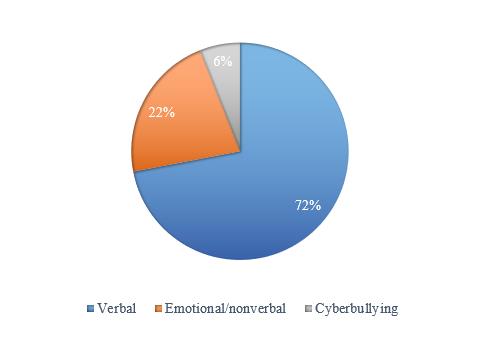
Out of the total number of teachers, 57% of believe that bullying/cyberbullying is rather rare, whilst 13% of them disagree, claiming that bullying occurs on a daily basis at the schools they teach (see Figure 2).
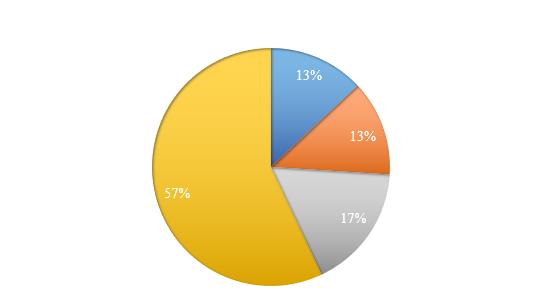
Teachers have been asked about the frequency at which children address the potential agressive behaviour they are subject to or witness to. As the table also shows, 43% of the answers state that this type of communication is pursued monthly, whilst 26% rarely talk about these issues. 22% bring up the subject weekly, whilst only 9% do it daily (see Figure 3).
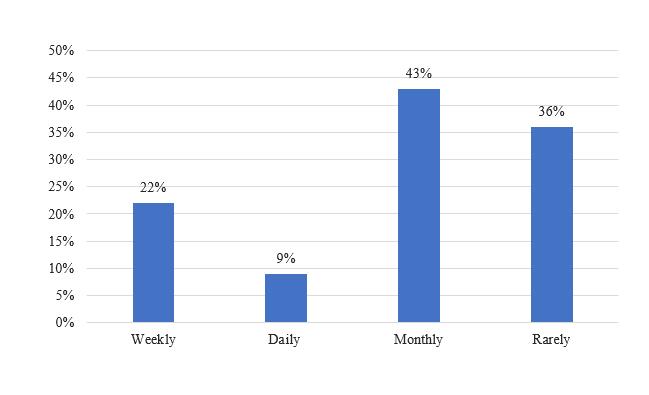
The teachers have also addressed a few situations in which pupils/students were subjects to repeated bullying, such as:
- Verbal aggression in regards to: physical appearance, ethnicity, economical situation, school performance.
- ‘Those who are perceived as being different than the ones which make up the group, they are trying to fit in are marginalized and stigmatized.’
- Those who perform very well in school are known as ‘bookworms’
- ‘It varies - sometimes it’s bullying coming from very good performers directed towards those who try, but simply lack the results – other times, it’s about those who are not so well off - but the consequences, the consequences are never alike’
The teachers believe, as well, that their pupils/students feel safe when in school, even if bullying is something which does occur sometimes.
‘Some of them are immune to such aggressions – they do not feel threatened, so to speak, given the context – but those who are constantly under violent pressure are, of course, quite affected’
The type of intervention identified by the school/teachers/counsellors/psychologists as efficient when trying to prevent bullying/cyberbullying in school has been illustrated in Figure 4. Individual intervention whilst the event is taking place has been present in 67% of the answers.
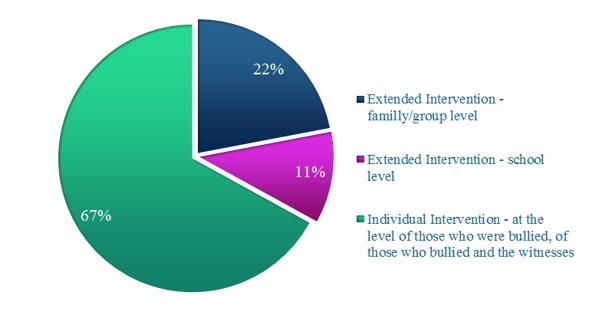
After taking a closer look at the answer which the teachers have provided us with, Table 1 and Table 2 have been devised, showcasing the effects which bullying has upon the victim and upon the aggressor respectively.
Those who witness bullying may be affected in the same way as the victim itself (see Table 3):
The first person to come to mind when in need of help after having been bullied would be either one of the parents or the head teacher, as per our findings. 24 of the teachers with which we have worked believed that the parents would be those to whom the pupil/student would go to when in need of help – then, 17 answers stated that the head teacher would be the one firstly asked for help – see Figure 5.
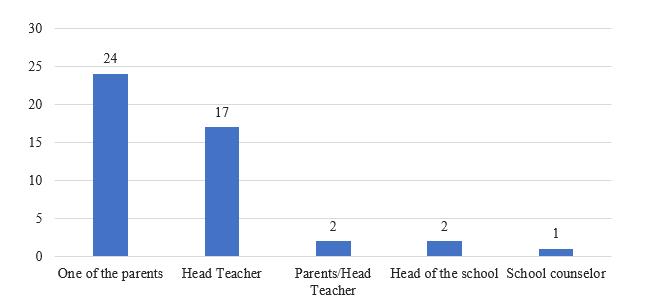
These are some ideas in regards to how bullying can purposefully and efficiently be counteracted within Romanian schools:
- Pupil/student - parents counselling activities, organised together with the Psychological Department of the Babeș-Bolyai University
- Methodical activities organised by the Headmaster and School Council in collaboration with CCD - " Cyberbullying - from virtual to real", " I act responsibly in the digital age ";
- The " I act responsibly in the digital age" county project;
- Roleplay activities
- Psychological counselling: Head Teacher – pupil/student – school psychologist/counselor
- Head teacher guidance activities
- Parent meetings and discussion sessions;
- Methodical activities;
- Presentations on "Bullying and cyberbullying";
- Pupil/student activities meant to spread awareness.
These are the forms of intimidation/bullying which occur most often in schools (Figure 6). As the graph states, 74% of the cases are reported by the teachers as pupil/student to pupil/student aggression.
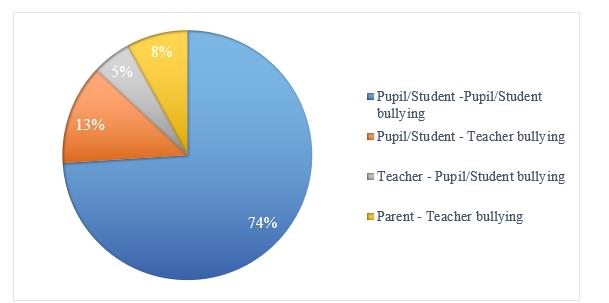
Our participants have identified bullying and cyberbullying in their schools and this is what they propose:
Punctual and individual management of the incident
- Informing the pupils/students, the parents and the other teacher of the fact that law 221/2019 in regards to psychological violence and bullying has passed;
- Seeking help from the school counselor;
- Undertaking several educational activities together with teachers, pupils/students, parents and other members of the local community;
- Introducing a centralized surveillance system;
- Teacher meetings meant to discuss procedures in case of a bullying incident;
- Counselling those who partook in cases of bullying/cyberbullying;
- Introducing activities meant to prevent and clear away the effects of the phenomena under the guidance of psychologists;
- Introducing a board tasked with counteracting school violence, planning activities lead by psychologists on relevant topics, individual discussions with those involved in such cases, meetings with their parents. Introducing themes in the curricula about these issues could also be a great help
There are several actions which can be undertaken by the institution (the headmaster, the teachers and general personnel) and the parents which may help with the prevention of bullying/cyberbullying
- A very close relation between the parents and the teachers (since children tend to open up to their parents);
- Roleplay, educational documentaries and films;
- Properly instructing teachers through formation courses in regards to psychological violence and bullying;
- Discussions and therapy sessions with both the aggressor and the victim;
- Maintaining efficient contact and communication between the parent, school counselor, head teacher and headmaster;
- Activities lead by specialists in the field;
- Personal development activities;
- Talk sessions with the pupils/students in order to identify and prevent the phenomena;
- The introduction of juridical education in school;
- Forming courses organized for teachers, meant to properly instruct them when it comes to tackling these situations.
During our research and focus groups sessions, we have also asked the participants to differentiate bullying and violence. As per the 6th article of law 221/2019, psychological violence is:
6. Psychological violence - bullying is an event or a series of physical, verbal, relational, and/or cybernetic events, having knowingly and deliberately occurred in an unavoidable social context, which has the goal of creating a power gap, undermining, consequently, one’s dignity, purposely intimidating, antagonizing, degrading, humiliating and/or offending an individual or a group of individuals which is perceived as socially excluded, either on racial, national, ethnic, religious or social grounds or because of other protected categories, such as gender, sexual orientation, personal characteristics, personal actions or behaviours undertaken within the bounds of any sort of educational institution.’
After having processed the data (Table 4), one may conclude that our subjects could define the concept of violence only in a shallow way. Even though several ideas have been mentioned, the way in which they have tackled the idea is not satisfactory.
In general, the process of social change is not an easy and fast one. People prefer the certainty, stability and safety and, therefore, any change can be and is often regarded with at least suspicion, distrust and met with resistance. There are few who meet the change, accept and adopt it without reservation. Adapting to change is gradual, each individual and each organization going through a particular cycle of change, characterized by a series of steps or stages required (Bocoș et al., 2015).
Another conclusion which we have managed to draw was the fact that the majority of teachers considered it necessary to introduce formation courses which could help them identify bullying incidents
in their schools and classrooms (Figure 7). This is in conformity with what article 56 of law 221/2019 states: ‘Formation courses shall be introduced in order to ensure that the didactic personnel have the necessary knowledge to identify, prevent, manage and handle cases of psychological violence – bullying by use of adequate educational strategies’
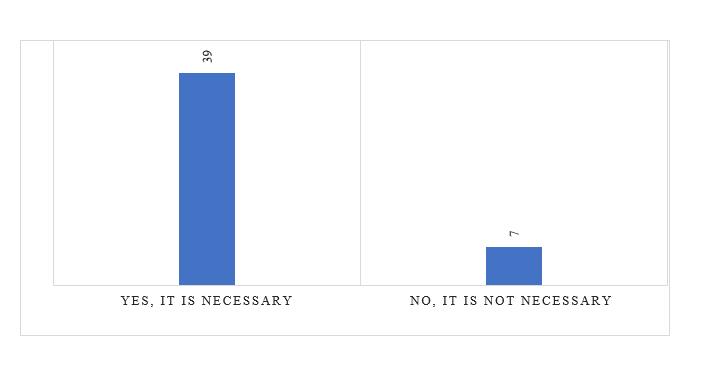
Conclusions
The teachers have succeeded in identifying the forms of bullying which led to discomfort, confusion and humiliation amongst the pupil/students they are in contact with. For the most part, the phenomena identified are those relating to verbal-, emotional-, nonverbal- and cyberbullying. The divide between the answers we have received from the teachers we have been in contact with show us that there are people who have accepted and realized that bullying is an issue, but that there are also some who deny its importance. Some of our participants have claimed that bullying happens rarely, whilst other stated it will occur weekly or even daily. Bullying tends to be something which insults and attacks physical appearance, ethnicity, economic situation, school performance or even material differences. Teachers feel, however, that students tend to think they’re safe within school limits. There are children who apparently react in no way to bullying, or not directly at least, because they bottle up negative feelings, fear and stress. Likewise, some of them appear to be more affected under constant pressure and they have strong emotional impulses when conflicted with cyberbullying and bullying generally speaking. Teachers would rather intervene directly in the midst of the conflict in such a way that they discuss the situation with the victim, the aggressor, the witness and their parents as soon as possible.
The effects which bullying has upon the victim have a personal, social and emotional impact. Bullying/cyberbullying leaves those who partake the phenomena feeling shame, stress, fear, fury, all leading up to disruptive behaviour: lack of participation to class activities, lack of interest in regards to school, defensive attitude, lack of motivation. The aggressor has been described by our participants as egocentric, furious and as displaying a superiority complex as a consequence of low self-esteem. Social-wise, the aggressor applies pressure upon the group he’s a part with, both upon the victims, as well as upon to those who do not oppose him. The aggressor feels a short and false boost in self-esteem which will impact him emotionally and socially in the long run. Those who witness bullying feels fear, mercy, revolt, unhappiness and discomfort, often times taking part to the aggression. Sometimes, the witness is indifferent and refuses communication when asked what has happened. Our participants feel like the parent is the one to which those affected seek help from, as he must be the one in which the individuals place more trust. Next in line is the head teacher.
As a conclusion, that which properly determines how much the anti-bullying regulations are met is how much anti-bullying behaviours are encouraged in the pre-tertiary Romanian educational institutions.
Properly instructing teacher helps a lot in these situations. More often than not, the victims believe that seeking help will not change a thing, as they will not be believed that they have been bullied. Some are also afraid of the consequences of telling. This, coupled with the fact that the solutions employed in order to prevent bullying are rarely of any success, makes it so that children never feel actually safe.
References
Badea, D., Farca, S., & Velea, S. (2011). Responsabilitatea profesorului în formarea moral afectivă a tinerilor [The teacher's responsibility in the emotional moral formation of young people]. Institutul de Științe ale Educației [Institute of Educational Sciences].
Benga, O., Băban, A., & Opre, A. (2015). Strategii de prevenție a problemelor de comportament [Behavior prevention strategies]. ASCR Publisher.
Bocoș, M, Chiș, O., & Răduț, R. (2015). Tratat de management educational pentru invatamantul primar si prescolar [Educational management treaty for primary and preschool education]. Publisher Paralela.
Bocoș, M., Taciu, R., & Chiș, O. (2015). Individual changes and organizational change. Exemplifications for the Romanian preschool teaching system. Procedia - Social and Behavioral Sciences, 209, 90-95. DOI:
Dulamă, M. E., Magdaș, I., & Chiș, O. (2020). Role Of Didactic Films Made By Master’ Students In Developing Didactic Competence. In & V. Chis, Prof. PhD. (Ed.), Education, Reflection, Development – ERD 2019, Vol. 85. European Proceedings of Social and Behavioural Sciences (pp. 704-712). European Publisher. DOI:
Olweus, D. (1994). Annotation: Bullying at School: Basic Facts and Effects of a School BasedIntervention Program. Child PsychoL Psychiat, 35(7), 1171-1190. https://www.researchgate.net/publication/245590401_Bullyvictim_problems_among_school_children_Basic_facts_and_effects_of_a_school_based_intervention
Save Children Romania. (2016). Bullying-ul în rândul copiilor. Studiu sociologic la nivel national [Bullying among children. Sociological study at national level]. https://www.salvaticopiii.ro/sci-ro/files/10/10551dfa-f0b2-4cb0-a103-08d811dc31a9.pdf
Trifan, I. M., & Chiș, O. (2017). Social and emotional development in the early years. Proceedings of the Conference: Education, Religion, Family in the Contemporary Society, 133-140.
Copyright information

This work is licensed under a Creative Commons Attribution-NonCommercial-NoDerivatives 4.0 International License.
About this article
Publication Date
23 March 2022
Article Doi
eBook ISBN
978-1-80296-955-9
Publisher
European Publisher
Volume
2
Print ISBN (optional)
-
Edition Number
1st Edition
Pages
1-803
Subjects
Education, Early Childhood Education, Digital Education, Development, Covid-19
Cite this article as:
Mirela, M. L., & Stan, N. (2022). The Perception Of Didactic Personnel Upon Bullying And Cyberbullying. In I. Albulescu, & C. Stan (Eds.), Education, Reflection, Development - ERD 2021, vol 2. European Proceedings of Educational Sciences (pp. 679-690). European Publisher. https://doi.org/10.15405/epes.22032.67

